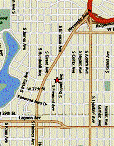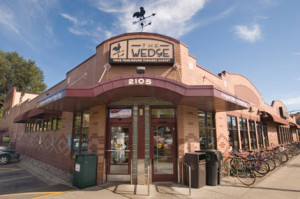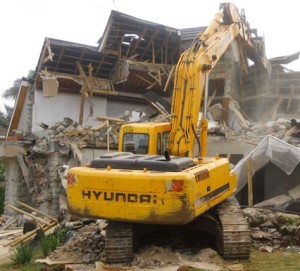
Welcome to the
Healy Project
Join us on Facebook
Send us an Email
Revoltin’ Developments, Part I
I. The Sad History of Zoning in the Wedge (Lowry Hill East)
 |
| Map of Lowry Hill East |
As followers of the Healy Facebook page know, in October, the Zoning and Planning Committee for the Lowry Hill East Neighborhood Association (LHENA) met to look at a proposal by the Lander Group to redevelop a site on the northwest corner of Colfax Avenue and 24th Street in the Wedge. The proposal, presented by Peter Keely of Collage Architects, called to wreck two extant houses, 2316 and 2320 Colfax, and erect a five-story, 48-unit apartment building. While emphasizing the “green” aspects of the proposed building, Keely also repeatedly stressed that it was considerably smaller than R-6 zoning allows.
After Keely’s presentation, the large group in attendance spoke of their concerns. Comments ranged from outrage at the size of the project to arguments in support of it from the man who owns the two houses, Michael Crow. The majority of the response was decidedly negative. At the end of the discussion, Steve Benson, chair of the 2004 LHENA Zoning Task Force. spoke eloquently of the need to secure the livability of the neighborhood by preserving the extant houses. Keely, after saying earlier that the proposal was the only “economically feasible” one for Lander, agreed to come back with another one at the November meeting.
What has all this to do with Healy? The Orth House at 2320, currently a 17-unit rooming house, was designed and built by Healy. According to Michael Crow, the original architectural features are gone, and it would be no loss to wreck it. The architect reported that City Planning agrees, saying that it has “no historical value.” Well, if the house really is as torn up as they contend, I wonder who’s responsible. Could it be Crow, who has run the place as a rooming house for the 21 years he’s owned it?
I will return to the historical and architectural importance of 2320 in another post, but now I’d like to focus on zoning issues and how they relate to preservation. I know, zoning is one of those topics that put people to sleep. But before you start dozing off, please try to keep awake long enough to learn the background of zoning in the Wedge.
In 1963 the City upzoned much of Minneapolis, including the Wedge, to high density R-6 zoning. These were the postwar days when much of old Minneapolis fell to the wrecking ball (the Metropolitan Building, for example). When the Wedge was upzoned, the houses started to come down by the scores, replaced by two-and-a-half story walkup apartment buildings. The City made the north-south streets into “paired commuter one-way corridors”, that is, racetracks for suburbanites to speed through the scary inner city.
In 1970, a group of Wedge residents banded together to form LHENA for the purpose of cleaning up and stabilizing the neighborhood. They picked up trash, they fought slumlords, they put unruly tenants on notice, they started “The Wedge” neighborhood newspaper. Their main goals, however, were to better control traffic flow and to downzone the Wedge to a lower density designation.
 |
| Minneapolis’s first co-op market, the Wedge, was founded in 1974. |
Amazingly, LHENA partially succeeded in meeting these goals by getting rid of the north-south one-ways and by downzoning the inner core of the area south of 24th Street to R-2B. North of 24th Street, however, R-6 zoning remains in place for all of the existing houses. In 2004 LHENA’s Zoning Task Force submitted a detailed plan to the City, arguing why downzoning the Wedge apex is essential for retaining the unique character and livability of the neighborhood. The City (figuratively) threw the study into the wastebasket. Apparently the City is quite happy with R-6 in the apex and is looking forward to cramming into it as many units as possible.
On November 14th, Peter Keely returned to the LHENA Zoning and Planning Committee with a new plan for the 2316-20 redevelopment. The revised proposal, it turns out, requires no variances from the City to build. Big surprise, eh? The fact is that as long as R-6 zoning is in place, developers can build pretty much whatever they want, without the blessing of the community. Presenting this plan to the zoning committee is simply window-dressing for Lander. At the second meeting, the focus was on hearing and commenting on the proposal. Anders Christensen was allowed to speak briefly on the historical significance of the houses. A man who identified himself as a supporter of Michael Crow claimed that the Minnesota Historical Society says that 2320 has no historical importance (more on this in next post), and the committee’s attention returned to issues such as parking, the placement of garbage cans, the wonders of brownstone, etc. “Progress” marched on.
 |
| Returning soon to the Wedge? |
The most alarming aspect of this seemingly benign proposal is that it signals a return to the Bad Olde Days of house demolition, with the attendant fallout of displaced tenants. After nearly four decades of stability, the residents of Lowry Hill East–and those at City Hall–must decide if they really want to see the apex of the Wedge turned into a nondescript Midwestern version of the Bronx, indistinguishable from other redeveloped urban areas–or if they want to retain the distinctive charm of the existing blend of houses and smaller apartment buildings.
The reality is that with R-6 zoning, developments like this cannot be stopped via the mechanism of City government. But that is not to say they can’t be stopped. Lowry Hill East’s nickname “The Wedge” came about not only to reflect the shape of the neighborhood, but the direction of its political thrust.
If and when these two houses fall, others will inexorably come down, too. It would be the end of the Wedge as we know it. Preservationists, those who love the Wedge and its houses, it’s time to stand up and be counted.
–T.B.
Next: The architectural and historical importance of Healy houses in the Wedge.